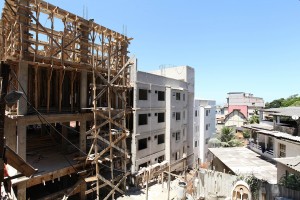
Current research shows that many of Rio de Janeiro’s favelas are continuing to grow, despite recent evictions of settlements and containment efforts by the city. Since 2008 Rio de Janeiro has been attempting to contain, and in some cases remove, favela settlements in the path of mega-event construction and real estate development, a process that has magnified in the run-up to the Rio 2016 Olympic Games.
According to the Instituto Pereira Passos (IPP), the Favela Cláudio Franco in Sepetiba in Zona Oeste (West Zone) jumped from 336 square meters to 1,163 square meters, an increase of no less than 246 percent. In 2010, after six years without growth (2004-2009) it reached 459 square meters; then increased to 572 square meters in 2011; and 957 square meters in 2012; and the following year, reached 1,163 square meters. However, since 2013 the growth of the community has no longer been monitored.
When history teacher Marcelo Costa, 54, moved there fifteen years ago he had only three neighbors. Now he told O Globo, “Many people arrived in recent years. With the arrival of new residents, the sewage treatment system can not cope and leaks are common. As the access road was not enlarged, there are traffic jams in the community entrance.”
The second fastest growing community since 2009 is also in the West Zone. That year, the Favela do Gouvêa in Paciência covered an average 6,926 square meters. Since then it has expanded its size by 60.49 percent, showing an increase across all surveyed years (2010-2013). In 2013, its size reached 11,116 square meters.
“In Barra and Recreio, the expansion of favela communities is due to the proximity to the labor market. In the region of Campo Grande and Santa Cruz, where the purchasing power is lower, there are more spaces available for irregular occupations, often overseen by militias,” architect Luiz Fernando Janot told O Globo.
Authorities are struggling to contain the natural growth of communities in the Zona Sul (South Zone) as well. Last week the city demolished five homes in the woods of the Morro do Cantagalo, in Ipanema. The favela community of Pavão-Pavãozinho in Copacabana also continues to grow visibly according to area residents, with four new brick houses seen being built in recent months.
In December 2011, the Brazilian Statistics Bureau IBGE (Instituto Brasileiro de Geografia e Estatistica) released the findings from its 2010 census which state that 22.03 percent of the 6,323,037 residents of Rio de Janeiro live in favelas, or irregular housing communities, representing a growth of favela population of 27.65 percent over ten years. That is in stark contrast to the growth of population in the rest of the city, which has increased only 3.4 percent, from 4,765,621 to 4,929,723 in ten years, showing expansion that is approximately eight times slower.
The next monitoring of the growth of favela communities has been postponed several times and new data is only expected for 2016 with the inclusion of an analysis of vertical growth. Nevertheless, Rio Mayor Eduardo Paes claims that the last data from 2013 shows a reduction in the areas with favela housing by 2.13 percent since 2008.
A project, announced in 2009, to construct walls around the communities has stalled. Construction started around the favela of Dona Marta (also known as Santa Marta) in Botafogo. This was the first of many walls planned for Rio’s favelas, with seven miles of wall to be built around at least eleven of Rio’s favelas in 2009 and around forty more by 2010.
Also underway have been the evictions and demolition of favela communities, many cited as necessary for Olympic-related development. Perhaps the most visible has been Vila Autódromo, which was founded by fishermen in 1967 in Barra da Tijua – but sits next to where the 2016 Olympic Games will take place – and has put many of Vila Autódromo’s homes at risk of demolition.
New irregular favela settlements have been combated by the city, as in April last year, when people first began to occupy the Telerj site of 50,000 square meters, owned by the telephone company Oi, dividing lots and rapidly building barracos (huts) in which to live. An estimated 5,000–6,000 families were living there by the time the police force came to clear the area eleven days later